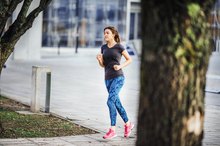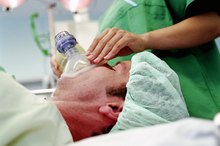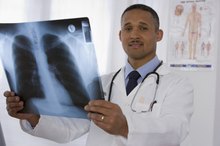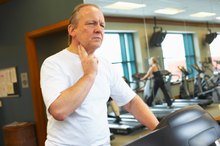What does fact checked mean?
At Healthfully, we strive to deliver objective content that is accurate and up-to-date. Our team periodically reviews articles in order to ensure content quality. The sources cited below consist of evidence from peer-reviewed journals, prominent medical organizations, academic associations, and government data.
- Clinical Methods: The History, Physical, and Laboratory Examinations, 3rd Edition; Sheldon R. Braun
- Clinical Methods: The History, Physical, and Laboratory Examinations, 3rd Edition; Sheldon R. Braun
The information contained on this site is for informational purposes only, and should not be used as a substitute for the advice of a professional health care provider. Please check with the appropriate physician regarding health questions and concerns. Although we strive to deliver accurate and up-to-date information, no guarantee to that effect is made.
What Are the Steps of Breathing?
Breathing provides your body with a way to exchange gases with the atmosphere. It provides the oxygen that your organs need to survive. And it also allows your body to get rid of gases that it does not need, like carbon dioxide. Breathing is a complicated process, but it occurs subconsciously without you even being aware of its different steps: stimulation of the respiratory control centers in your brain, inhalation, gas exchange and exhalation.
The Urge to Breathe
The urge to breathe comes from the respiratory center, located at the base of your brain. It sends signals via the spinal cord to your diaphragm and the muscles between your ribs telling them when to contract or relax. There are also sensors that control respiration in the major arteries of your body. While your breathing rate changes -- for example when you exercise or are anxious -- your urge to breathe is based primarily on the amount of carbon dioxide in the blood. With higher levels of carbon dioxide, your breathing rate increases.
- The urge to breathe comes from the respiratory center, located at the base of your brain.
- There are also sensors that control respiration in the major arteries of your body.
Inhalation
Importance of Breathing During Exercise
Learn More
When you breathe, the diaphragm -- the large muscle that divides your chest and abdomen -- contracts and moves downward. Additionally, your ribs move outward. This enlarges your chest and your lungs expand. Lung expansion creates a vacuum 1. Air enters your nose and mouth and is pulled into your windpipe -- the trachea. The trachea divides into smaller airways called bronchi. These continue to divide as they get farther from the trachea, like the branches of a tree. Finally, the tiny airways deliver the air to the smallest structures in your lung -- the alveoli -- where gas exchange takes place.
- When you breathe, the diaphragm -- the large muscle that divides your chest and abdomen -- contracts and moves downward.
- Finally, the tiny airways deliver the air to the smallest structures in your lung -- the alveoli -- where gas exchange takes place.
Gas Exchange
There are millions of alveoli in your lungs surrounded by a mesh of tiny blood vessels, called capillaries. Both the alveoli and the surrounding capillaries have very thin walls. Oxygen readily passes through the alveolar walls into the blood vessels, where it is carried to the rest of your body to be used by the cells. Similarly, the metabolic waste product carbon dioxide readily crosses from your blood into the alveoli to be eliminated by exhalation.
- There are millions of alveoli in your lungs surrounded by a mesh of tiny blood vessels, called capillaries.
- Oxygen readily passes through the alveolar walls into the blood vessels, where it is carried to the rest of your body to be used by the cells.
Exhalation
What Happens to Your Lungs When You Exercise?
Learn More
Exhalation is the process by which excess carbon dioxide is eliminated from your bloodstream. Carbon dioxide-rich blood travels to the capillary network surrounding the alveoli in your lungs. Carbon dioxide crosses through the thin walls of the capillaries into the alveoli. Your diaphragm and the muscles between your ribs relax, which allows your chest wall to move back to its resting position. As it does so, air is pushed out of your lungs, through your trachea and into the atmosphere.
- Exhalation is the process by which excess carbon dioxide is eliminated from your bloodstream.
- Carbon dioxide-rich blood travels to the capillary network surrounding the alveoli in your lungs.
Related Articles
References
- Lung Fuction; John E. Cotes et al.
- Clinical Methods: The History, Physical, and Laboratory Examinations, 3rd Edition; Sheldon R. Braun
- Merck Manuals Home Edition: Exhanging Oxygen and Carbon Dioxide
- Merck Manuals Home Edition: Respiratory System
- Knudsen, L., and M. Ochs. The Micromechanics of Lung Alveoli: Structure and Function of Surfactant and Tissue Components. Histochemistry and Cell Biology. 2018. 150(6):661-676. doi:10.1007/s00418-018-1747-9
- Hsia C, Hyde D, Weibel E. Lung Structure and the Intrinsic Challenges of Gas Exchange. Comprehensive Physiology. 2016. 6(2):827-895. doi:10.1002/cphy.c150028
- Knudsen L, Ochs M. The micromechanics of lung alveoli: structure and function of surfactant and tissue components. Histochemistry and Cell Biology. 2018. 150(6):661-676. doi:10.1007/s00418-018-1747-9
- Trapnell BC, Nakata K, Bonella F, et al. Pulmonary alveolar proteinosis. Nature Reviews. Disease Primers. 2019. 5(1):16. doi:10.1038/s41572-019-0066-3
- Kasper, Dennis L.., Anthony S. Fauci, and Stephen L.. Hauser. Harrison's Principles of Internal Medicine. New York: Mc Graw Hill education, 2015. Print.
Writer Bio
Dr. Terry L. Levin is professor of clinical radiology at a New York childrens hospital where she has been for 15 years. She received her MD from Cornell University Medical Center,completed her radiology residency at New York Hospital-Cornell Medical Center and her fellowship in pediatric radiology at Columbia Presbyterian Medical Center.









